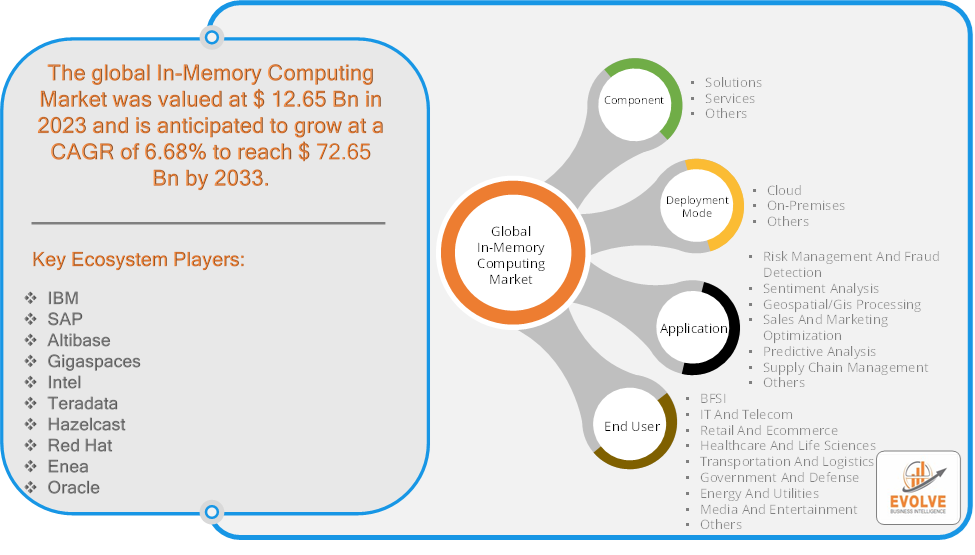In-Memory Computing Market: 6.68% CAGR Forecast

Evolve Business Intelligence has published a research report on the Global In-Memory Computing Market, 2023–2033. The global In-Memory Computing Market is projected to exhibit a CAGR of around 6.68% during the forecast period of 2023 to 2033.
Evolve Business Intelligence has recognized the following companies as the key players in the global In-Memory Computing Market: IBM, SAP, Altibase, Gigaspaces, Intel, Teradata, Hazelcast, Red Hat, Enea and Oracle.
 More Information: https://evolvebi.com/report/in-memory-computing-market-analysis/
More Information: https://evolvebi.com/report/in-memory-computing-market-analysis/
Market Highlights
The Global In-Memory Computing Market is projected to be valued at USD 72.65 Billion by 2033, recording a CAGR of around 6.68% during the forecast period. The In-Memory Computing (IMC) Market refers to the industry focused on computing technologies that store data in a computer’s main memory (RAM) rather than on traditional disk storage. This approach enables much faster data processing and retrieval, which is particularly beneficial for applications requiring real-time data analytics, complex computations, and high-speed transaction processing.
The In-Memory Computing Market is evolving rapidly as organizations seek to leverage the technology’s capabilities to gain insights from their data more quickly and efficiently. As data volumes continue to grow and businesses seek to gain a competitive edge, the demand for in-memory computing solutions is expected to rise.
The COVID-19 pandemic had a significant impact on the In-Memory Computing (IMC) Market. Many businesses accelerated their digital transformation initiatives to adapt to remote work and digital operations. This increased the demand for in-memory computing solutions, which enable real-time data processing and analytics. The surge in e-commerce and online services due to lockdowns and social distancing measures led to increased data volumes, requiring faster processing capabilities provided by in-memory computing. While the demand for digital solutions increased, many organizations faced budget constraints due to the economic impact of the pandemic. This led to a careful evaluation of technology investments, including in-memory computing. Managing a remote workforce required enhanced IT infrastructure, including in-memory computing, to support applications and data processing without latency. The pandemic accelerated the shift towards cloud computing, with many organizations moving their workloads to the cloud. Cloud-based in-memory computing solutions became more attractive due to their scalability and flexibility.
Segmental Analysis
The global In-Memory Computing Market has been segmented based on Component, Deployment Mode, Application and End User.
Based on Component, the In-Memory Computing Market is segmented into Solutions, Services and Others. The Solutions segment is anticipated to dominate the market.
Based on Deployment Mode, the global In-Memory Computing Market has been divided into the Cloud, On-Premises and Others. The Cloud segment is anticipated to dominate the market.
Based on Application, the global In-Memory Computing Market has been divided into the Risk Management And Fraud Detection, Sentiment Analysis, Geospatial/Gis Processing, Sales And Marketing Optimization, Predictive Analysis, Supply Chain Management and Others. The Risk Management And Fraud Detection segment is anticipated to dominate the market.
Based on End User, the global In-Memory Computing Market has been divided into the BFSI, It And Telecom, Retail And Ecommerce, Healthcare And Life Sciences, Transportation And Logistics, Government And Defense, Energy And Utilities, Media And Entertainment and Others. The It And Telecom segment is anticipated to dominate the market.
More Information: https://evolvebi.com/report/in-memory-computing-market-analysis/
Regional Analysis
The In-Memory Computing Market is divided into five regions: North America, Europe, Asia-Pacific, South America, and the Middle East, & Africa. North America is one of the largest and most advanced markets for in-memory computing, driven by the presence of major technology companies and high adoption rates of advanced IT solutions. The financial services and healthcare sectors are significant adopters, leveraging in-memory computing for real-time data processing and analytics. Europe is experiencing increasing adoption of in-memory computing solutions, particularly in industries such as manufacturing, retail, and finance. The region’s focus on Industry 4.0 and IoT integration is boosting the need for real-time data processing capabilities. The Asia-Pacific region is witnessing rapid growth in the in-memory computing market, fueled by the digital transformation of economies and the expansion of industries such as e-commerce, telecommunications, and manufacturing. Countries like China, India, Japan, and South Korea are leading the adoption due to their large populations, growing economies, and increasing investments in technology infrastructure. Latin America is an emerging market for in-memory computing, with growing interest from industries such as banking, telecommunications, and retail. The increasing penetration of cloud computing and IoT in the region is expected to boost the demand for in-memory computing solutions. The Middle East and Africa region is gradually adopting in-memory computing technologies, particularly in sectors like oil and gas, finance, and government. As the region continues to embrace digital transformation, there are significant opportunities for in-memory computing providers to expand their presence and cater to the growing demand.
